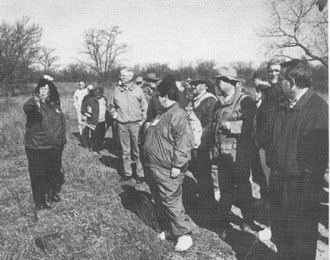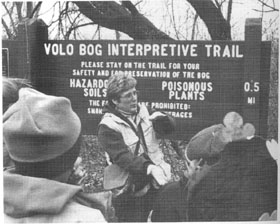OUR NATURAL RESOURCES
Translating the
Language of Nature
Illinois state park interpreters explain nature
in ways the average person can understand
|
By DAVE AMBROSE
Stacy Miller, the interpreter of Volo Bog State Natural Area, tells the story of the bog man to fifth graders from a nearby school.
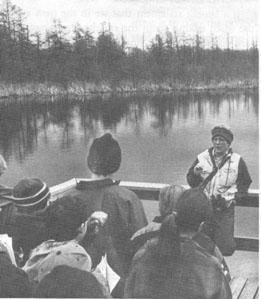
|
"Gather around and I will tell you the story of the
Boogey Man."
Stacy Miller, site interpreter at Volo Bog State Natural Area in Lake County, stands on a wooden deck
overlooking one of Illinois' most unique wetlands, gathering a clutch of sixth-graders around her like a mother
hen. Then, adopting the voice of a campfire storyteller,
she recalls how European peat bogs were favored hideouts for Medieval thieves and murderers on the lam.
Children who wandered into the bogs against the advice of their parents could become victims of the "bog
men," who hid the bodies of their small victims beneath the floating mats
of spaghum moss.
Over the centuries the
"bog man" evolved
into the "Boogey
Man," the archetypical
monster under the
bed.
Such stories are but
a small part of the park
interpreter's repertoire.
Using household objects like a sponge and
kitchen strainer. Miller
explains the environmental significance of
wetlands. She engages
children in games such
as "Bat and Moths"
and "Hawk and Rabbits" to illustrate the
complex relationship between predator and prey. |
At the Illinois and Michigan Canal State Trail, interpreter Judy Schoenberger dons the costume of a young
19th-century woman named Maggie to explain how
the canal affected local economics and lifestyle. Veteran
interpreter Toby Miller at Starved Rock State Park leads
nature hikes, teaches cross-country skiing and coaxes
visitors to take a ride in a Montreal canoe similar to
those used by French explorers to penetrate the Illinois
wilderness. At Illinois Beach State Park, Sue Wright
experiments with computers to electronically carry the
message of environmental education to classrooms
throughout the Chicago area. Indeed, the process of
park interpretation is as diverse as the individuals who
pursue the career.
"When I was a little girl, our family went on vacation
every year, usually to Yellowstone National Park, "Wright
recalled in her office at Illinois Beach. "I thought those
park rangers were really neat and I knew that's what I
wanted to be. My mother thought it was cute when I
was little, but by the time I was a teenager she was
beginning to think I should consider being a secretary."
Her mother's advice notwithstanding, Wright became
the first woman graduated from Utah State University
with a degree in forestry. Eventually she landed in Illinois as a park interpreter, first at Pere Marquette State
Park in southern Illinois and for the past 15 years at
Illinois Beach State Park on the shore of Lake Michigan. She was part of the first wave of park interpreters
hired by the old Department of Conservation in the
1970s, only to be eliminated during the slash and burn
budget cuts of the 1980s.
At its zenith, the park interpretive program employed
54/ Illinois Parks and Recreation
OUR NATURAL RESOURCES
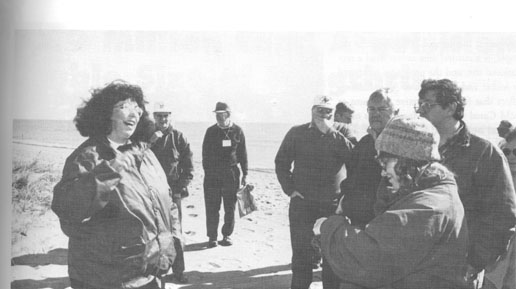
|
Sue Wright (left), interpreter at
Illinois Beach State Park, gives
visitors a tour of the park's natural area.
Stacy Miller (below) discusses
raptors and the differing ways
they find food to a visiting class of
sixth graders at Volo Bog Natural
Area.
|
27 full-time interpreters located at parks throughout
the state. But during the lean budget years of the 1980s,
layoffs reduced the program to just four interpreters,
all of whom were located at parks in northeastern Illinois where regional land managers fought hard to keep
the program alive.
"They said interpretation was important and they
fought for it," Wright recalled. She survived the layoffs
by transferring from Pere Marquette to Illinois Beach.
Today, the interpretive program is on the rebound,
enriching the outdoor experience for thousands of state
park visitors. Spurred by the first Conservation Congress' recommendation for more emphasis on environmental education, the Department of Natural Resources has embarked on a effort to revitalize the interpretive program statewide. With about 65 full-time and
part-time interpreters throughout the state, formal interpretive programs now are offered at 35 state parks,
recreation areas and natural areas.
"We have a director who supports us and believes in
the value of environmental education," Wright said.
The value of the interpretive program, according to
Mitch Ingold, DNR interpretive program coordinator, is that it improves park visitors' understanding of
nature in general and enhances their appreciation and
enjoyment of the specific park they are visiting.
"When people go to a park, they're looking for things
to do," Ingold said. Families using campgrounds are
frequent participants in interpretive programs. "You
can only do so much fishing and so much playing in
the playground. Eventually the kids get to the point
where they say, 'There's nothing to do.'"
The form interpretive programs take is a function of
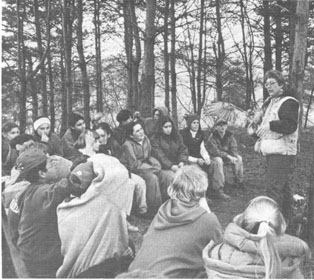
|
Spurred by the first Conservation
Congress' recommendation for
more emphasis on environmental
education, the Department of
Natural Resources has embarked
on an effort to revitalize the
interpretive program statewide.
|
September/October 1997/ 55
OUR NATURAL RESOURCES
Beach erosion is one of the
ongoing problems at Illinois
Beach State Park. Interpreter
Sue Wright talks about the
causes and some of the
solutions that might eventually
solve the problem (Bottom Left).
Interpreter Stacy Miller talks
about the depth of the water at
Volo Bog and how the bog is
continually closing in (bottom right).
the individual interpreter and the park
they serve, Ingold said. Volo Bog, for example, is a natural area rather than a recreational site, and the programs presented
by Miller and her stable of 30 volunteers
reflect that fact. Interpretive programs at
I&M Canal and Fort Massac focus more
on local history and less on nature. And
some sites, such as Illinois Caverns,
wouldn't even be open to the public without the presence of an interpreter.
Interpretive programs can range from
brief programs in the campgrounds to
guided tours of park features. But, as
Wright points out, park interpreters are
more than just tour guides.
"We've gone from being tour guides to
using more interactive programs," she said.
"Children aren't going to sit and listen to
a lecture anymore. They have to have something that's
more involving."
Often working with school groups and other groups
of youngsters, Wright may have children collecting life
forms from a pond to be examined under a microscope
or gathering data to monitor the quality of water filtering through a backwater marsh.
"My biggest reward is when I see that light come into
their eyes," Wright said. "Teachers can tell them things
in the classroom, but when they come here they actually see what they've been talking about. You can see it
in their eyes when they make the connection."
In a similar vein. Miller at Volo Bog relishes the moments when youngsters grasp the complexities of ecological relationships in Illinois wetlands. A few hours of
dealing with a group of unruly six-graders can be trying, but the reward comes from realizing she has reached
past the smart-alecky remarks and given them a unique
appreciation for nature.
"Sometimes, with all the smart remarks and everything, you wonder if they are getting anything out of
the program," she said. "But then you ask them a question and you find out that they did,"
Toby Miller at Starved Rock State Park provides interpretive service to nearly 100,000 park visitors annually. His programs reach out most often to groups that
include adults and children.
"My job is to interpret the language of the woods in a
way people can understand and enjoy," he said. To that
end, Miller's interpretive hikes involve more than just
plant identification. On a recent Wildflower Pilgrimage, Miller not only taught participants how to identify
plants, he also explained the origins of some of the colorful plant names, as well as how pioneers and Native
Americans used the plants medicinally and for food.
Recently, the DNR Interpretive Program took the next
step to enter the computer age. There is an Interpretive
Site on the DNR Homepage to keep Internet uses
abreast of which sites have interpretive programs and
what special events are coming up. Moreover, working
with DNR computer specialists, the Interpretive Program recently released a Virtual Reality tour of the I&M
Canal.
"The Internet is a great tool for getting information
into the schools and into homes," Ingold explained,
"and encouraging people to visit our sites in person."
DAVE AMBROSE
is a staff writer lor Outdoorlllinois. a publication of the Illinois Department of
Natural Resources. This article was reprinted with permission from the June 1997
issue of OutdoorIllinois.
56 / Illinois Parks and Recreation
OUR NATURAL RESOURCES NEWS BRIEFS
$3.9 Million Land Acquisition Will
Double Size of Sangchris
The state will purchase 1,186 acres of land
est of Sangchris Lake near Springfield from
Commonwealth Edison to nearly double
the size of Sangchris Lake State Park, according to Governor Jim Edgar. The expansion will improve outdoor recreational opportunities and expand wildlife habitat in
central Illinois.
"Sangchris Lake State Park represents an
important recreational site to the half-million central Illinois residents who visit and
enjoy the park each year, " the governor said.
"We have invested millions of dollars in
the park, and we have an opportunity to
nearly double the size of the park with
ComEd's decision to sell more than 5,000
acres of land it owns.
"At the same time, we'll be protecting the
integrity of the park from the possible encroachment of private development as
ComEd's other acreage is sold."
When ComEd sold its Kincaid Station
to Dominion Resources, Inc., earlier this
year, the state began negotiations to acquire
land on the west peninsula of Sangchris
Lake. The state currently owns 1,417 acres
on the north side of the lake, and has an
easement for recreational use of the 2,586-
acre fishing lake along with waterfowl, upland and habitat agreements with the utility.
"This acquisition will maintain the park's
many quality recreation programs, including hiking and equestrian trails, birding,
hunting, fishing and wildlife habitat development, " the governor said.
"The purchase agreement protects the integrity of all natural resource-based programs at the site. "
The $3.9 million purchase price will be
funded with $2.7 million from the Department of Natural Resources' Targets of Opportunities for Land Acquisition Fund,
along with a combined $1 million from the
state pheasant, migratory waterfowl and
habitat stamp funds, and $206,000 in other
DNR funds.
"This purchase would not be happening
without a strong commitment by ComEd
to assist the state with its recreational goals,
and the cooperation of many sportsmen's
groups which agreed to contribute to this
project, " said DNR director Brent Manning.
"It has been a team effort to expand, improve and protect this site. "
Much of the land currently being farmed
will continue to be leased for farming. The
remainder will be preserved for recreation
and wildlife habitat. The agricultural leases
will help maintain the property tax base for
both Sangamon and Christian counties.
"This purchase represents another in a
long line of projects my administration has
undertaken and supported to expand and
improve recreational opportunities and
wildlife habitat throughout the state,
Edgar said.
"We are pleased to cooperate with Governor Edgar and the state to protect and
enhance the recreational opportunities that
Sangchris Lake State Park provides to outdoor enthusiasts throughout Illinois, " said
Michael Norris, land management administrator for ComEd.
The purchase must be approved by the
Illinois Commerce Commission and
ComEd's board of directors.
The remainder of the utility's acreage in
the area is expected to be sold at public auction this fall.
"The Illinois Association of Park Districts commends Governor Edgar and Brent
Manning of the Department of Natural Resources for the excellent negotiations
in acquiring this land, " said IAPD executive director Ted Flickinger.
"Lake Sangchris has a reputation for being one of the finest fishing lakes in the
state of Illinois and offers great opportunities for camping, equestrian trails and
many other recreational pursuits. Increasing Sangchris Lake State Park also serves
as a buffer zone to protect the lake and surrounding wetlands.
"This is another example of Governor Edgar's commitment to natural resources
and open spaces in Illinois. "
|
Wetland Restoration Guide Available
A new guide to help improve the quality and success of restored and created
wetlands is now available from the Department of Natural Resources.
The Illinois Wetland Restoration and. Creation Guide includes chapters on planning, assessment, design, construction, monitoring and management. It was produced by DNR's Natural History and State Geological surveys and Office of Resource Conservation in cooperation with the Department of Transportations Division of Highways, which provided some financial support and assistance in
drafting portions of the document.
Guides are available from the Illinois Natural History Survey for $15, including
tax and shipping, and can be obtained by writing the INHS Publications Office,
607 E. Peabody Drive. Champaign, 111., 61820 or by calling 217.333.6880.
|
September/October 1997/ 57
OUR NATURAL RESOURCES NEWS BRIEFS
Illinois Boasts Many "Tree Cities"
Illinois is second among the 50 states in the number of communities
qualifying for Tree City USA designation. This year, 145 communitie of every size qualified by legally designating an individual or group
to care for urban forests, enacting a community tree ordinance, expending a minimum of $2 per resident for urban forestry and conducting an Arbor Day tree planting ceremony.
From the summer issue of the Prairie Tree Companion, following
are 19 Tree City USA communities whose urban forestry programs
offer unique aspects other communities might like to borrow.
ANTIOCH gave away up to five free evergreen seedlings to anyone who agreed to plant and care for them. Last year, more than
1,000 seedlings were distributed to area residents.
BENSENVILLE planted 153 parkway trees that were grown in
the village's perpetual nursery and signed a multi-year contract for
yard waste grinding.
BLOOMINGTON set up a committee with Illinois Power to implement a written set of guidelines regarding tree trimming near utility
lines.
COLLINSVILLE offers spring and fall clean-up projects for the
community's elderly and disabled persons. The city and its volunteers
prune trees, trim shrubs, rake leaves and perform general yard maintenance.
DECATUR learned the value of a good tree trimming program
when it was hit by back-to-back tornadoes. Trees that had been
trimmed suffered almost no damage, while those that hadn't were
severely impacted.
FRANKFORT has a "Baby Tree" program,
planting 33 trees in recognition of newborn
residents.
GLENCOE educates its residents through
a monthly "Tree-Mendous" column in them
monthly village newsletter.
LIBERTYVILLE purchased a computer
software package that allows it to keep track
of each tree. Residents who request it are provided with specific information about their
trees, including value estimates.
MOLINE held its Arbor Day ceremony at
the historic Willard School, built in 1895.
Students from each grade level planted trees
along 17th Ave., which borders the school.
The Tree City USA banner was then raised
on the school's flagpole, where it remained
for the rest of the year.
MT. VERNON has a slide presentation,
"The Right Tree in the Right Place," which
it presents to local civic organizations.
NORTHFIELD invited a landscape architect to its Arbor Day celebration to give a
presentation on proper pruning techniques as well as designing a
landscape plan.
OSWEGO worked with a developer to utilize trees from a tree
farm which is being turned into a new subdivision. Rather than destroy the trees, they were given to the village for its parkway plantings
program.
PALATINE achieved its goal of planting two trees for every tree
removed.
PALOS HILLS cleared an overgrown 10-acre site by thinning out
less desirable trees and trimming remaining trees, leaving a park that
has proved very popular.
ROSELLE celebrated Arbor Day by planting oak trees along a new
bike path.
SCHAUMBURG used a grant from the Department of Natural
Resources to conduct a mailing to residents about gypsy moths.
SKOKIE worked with Commonwealth Edison to replace 79 inappropriate trees under power lines.
VERNON HILLS is working to reforest a degraded oak woodland.
WARRENVILLE operates a city-wide plant exchange for residents
to swap garden plants.
Reprinted from the Summer 1997 issue of Prairie Tree Companion, a publication of the Illinois
Department of Natural Resources.
58/ Illinois Parks and Recreation
OUR NATURAL RESOURCES NEWS BRIEFS
Trees Offer Many Benefits Other
than Shade and Beauty
When it was published five years ago, the book Growing Greener
Cities told us that a mature city tree provides the following benefits:
$73 worth of air conditioning; $75 worth of wildlife benefits; $75
worth or erosion control; and $50 worth of pollution control, for a
total benefit value of $273 per year. When this value is compounded
at a rate of five percent annually for 50 years, the tree is worth
$57,151.
However, new information on the benefits of trees is on the horizon from a project titled "Benefits of Large Trees Relative to Maintenance Costs to Private Tree Owners." This project is funded by
the National Urban and Community Forestry Advisory Council's
grant program in partnership with the National Arborist Foundation, USDA Forest Service and the International Society of
Arboriculture Research Trust Fund.
The project's purpose was to create a model where the maintenance cost of a mature shade tree was compared to the environmental benefits.
In this study, the researchers looked at a range of environmental
values provided by a tree over a 15-year period. A red maple in
Cook County, Ill., that was 30 inches in diameter and 70 feet tall
with a 55-foot crown was studied. Opposite is a quick synopsis of
the tree's benefits.
BENEFITS
Energy savings $1,133
Water transpired 452,580 gallons
Storm water intercepted 25,260 gallons $281
Oxygen released 8,870 Ibs.
Air pollution 100 Ibs. $41
Carbon dioxide captured 17,040 Ibs. $21
Tree value increase $1,527
TOTAL ............................................................ $3,003
MAINTENANCE COSTS
Pruning $521
Fertilization $162
Integrated Pest Management $130
TOTAL............................................................... $813
In this situation, the mature red maple tree had a net present
value of benefits produced equal to $2,188. The benefit to cost
ration produced by this large tree is 4:1.
Reprinted from the Summer 1997 issue of Prairie Tree Companion, a publication of the Illinois Department of Natural Resources.
DNR's Urban and Community Forestry Program
Benefits Illinois Communities
Illinois' Urban and Community Forestry Program provides technical and financial assistance to communities and local units of
government to establish and maintain effective urban and community forests. Here's a progress report.
Since 1990, more than
$800,000 in grants have
been provided to 105
communities, generating a
local match of $880,000.
In 1996 alone, 29 communities received $187,275 in assistance.
Projects include 50 street tree
inventories, 21 management plans,
28 public education programs, 22 tree planting projects and development of 26 tree care ordinances.
Illinois leads the nation in the Tree City USA Growth Award
program and is second in the nation for the number of communities achieving Tree City USA status.
Eight Regional Urban and Community Forestry Councils have
been established. They provide educational materials to libraries, develop public service announcements, promote environmental education and conduct regional workshops.
Last year, 182,153 trees were planted, bringing the total over
the last four years to more than 835,000.
The program has assisted more than 1,200 communities and
1,265 community action groups.
Information about the program is available by calling
217.782.2361.
|
September/October 1997/ 59
|



